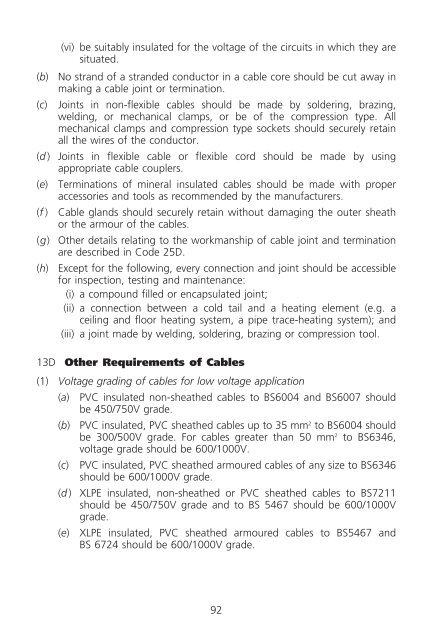Code of Practice for the Electricity (Wiring) Regulations - 2009 Edition
Code of Practice for the Electricity (Wiring) Regulations - 2009 Edition
Code of Practice for the Electricity (Wiring) Regulations - 2009 Edition
Create successful ePaper yourself
Turn your PDF publications into a flip-book with our unique Google optimized e-Paper software.
(vi) be suitably insulated <strong>for</strong> <strong>the</strong> voltage <strong>of</strong> <strong>the</strong> circuits in which <strong>the</strong>y are<br />
situated.<br />
(b) No strand <strong>of</strong> a stranded conductor in a cable core should be cut away in<br />
making a cable joint or termination.<br />
(c) Joints in non-flexible cables should be made by soldering, brazing,<br />
welding, or mechanical clamps, or be <strong>of</strong> <strong>the</strong> compression type. All<br />
mechanical clamps and compression type sockets should securely retain<br />
all <strong>the</strong> wires <strong>of</strong> <strong>the</strong> conductor.<br />
(d ) Joints in flexible cable or flexible cord should be made by using<br />
appropriate cable couplers.<br />
(e) Terminations <strong>of</strong> mineral insulated cables should be made with proper<br />
accessories and tools as recommended by <strong>the</strong> manufacturers.<br />
(f ) Cable glands should securely retain without damaging <strong>the</strong> outer sheath<br />
or <strong>the</strong> armour <strong>of</strong> <strong>the</strong> cables.<br />
(g) O<strong>the</strong>r details relating to <strong>the</strong> workmanship <strong>of</strong> cable joint and termination<br />
are described in <strong>Code</strong> 25D.<br />
(h) Except <strong>for</strong> <strong>the</strong> following, every connection and joint should be accessible<br />
<strong>for</strong> inspection, testing and maintenance:<br />
(i) a compound filled or encapsulated joint;<br />
(ii) a connection between a cold tail and a heating element (e.g. a<br />
ceiling and floor heating system, a pipe trace-heating system); and<br />
(iii) a joint made by welding, soldering, brazing or compression tool.<br />
13D O<strong>the</strong>r Requirements <strong>of</strong> Cables<br />
(1) Voltage grading <strong>of</strong> cables <strong>for</strong> low voltage application<br />
(a) PVC insulated non-shea<strong>the</strong>d cables to BS6004 and BS6007 should<br />
be 450/750V grade.<br />
(b) PVC insulated, PVC shea<strong>the</strong>d cables up to 35 mm2 to BS6004 should<br />
be 300/500V grade. For cables greater than 50 mm2 to BS6346,<br />
voltage grade should be 600/1000V.<br />
(c) PVC insulated, PVC shea<strong>the</strong>d armoured cables <strong>of</strong> any size to BS6346<br />
should be 600/1000V grade.<br />
(d ) XLPE insulated, non-shea<strong>the</strong>d or PVC shea<strong>the</strong>d cables to BS7211<br />
should be 450/750V grade and to BS 5467 should be 600/1000V<br />
grade.<br />
(e) XLPE insulated, PVC shea<strong>the</strong>d armoured cables to BS5467 and<br />
BS 6724 should be 600/1000V grade.<br />
92














